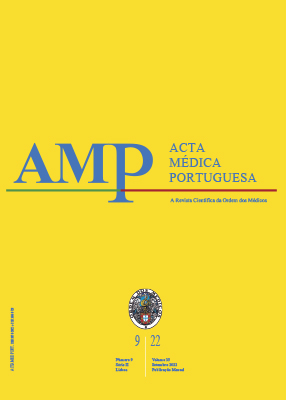Portuguese Version of the Stigma Scale: Preliminary Psychometric Characteristics
DOI:
https://doi.org/10.20344/amp.14623Keywords:
Dementia, Mental Health, Psychometrics, Social Stigma, Surveys and QuestionnairesAbstract
Introduction: Stigma is associated with poor prognosis of illness and reduced help-seeking behavior, self-esteem and treatment compliance. The aims of this study were to study the reliability and construct validity of the King’s et al Stigma Scale, and its association with Illness and Help-Seeking Behaviors scale (IHSBS) scores.
Material and Methods: One hundred and forty mental health patients filled out the Stigma scale and the Illness and Help-Seeking Behaviors scale. The exploratory factor analysis of the stigma scale was performed, and its reliability studied. The correlation analysis was used and mean differences in Stigma Scale scores among IHSBS groups were explored.
Results: The exploratory factor analysis indicated four factors (F): F1-Disclosure, F2-Discrimination, F3-Acceptance and F4-Personal Growth, which showed acceptable/good internal consistency (α from 0.70 to 0.91). Help-seeking behaviors were not associated with stigma. The levels of Discrimination were high in the group with global high-IHSB and in patients with medium/high illness behavior (IB) and health-related worries (HW). Additionally, Disclosure and overall stigma levels were higher in groups with high-HW and with medium-IB scores (when compared with the group with low-IB). The group with low-IB also had lower levels of Acceptance and Personal Growth when compared with the groups with medium-IB and high-IB, respectively.
Conclusion: The Stigma Scale (27 items) is a valid, reliable instrument and useful tool to assess stigma in mental health patients.
Downloads
Downloads
Published
How to Cite
Issue
Section
License
Copyright (c) 2022 Acta Médica Portuguesa

This work is licensed under a Creative Commons Attribution-NonCommercial 4.0 International License.
All the articles published in the AMP are open access and comply with the requirements of funding agencies or academic institutions. The AMP is governed by the terms of the Creative Commons ‘Attribution – Non-Commercial Use - (CC-BY-NC)’ license, regarding the use by third parties.
It is the author’s responsibility to obtain approval for the reproduction of figures, tables, etc. from other publications.
Upon acceptance of an article for publication, the authors will be asked to complete the ICMJE “Copyright Liability and Copyright Sharing Statement “(http://www.actamedicaportuguesa.com/info/AMP-NormasPublicacao.pdf) and the “Declaration of Potential Conflicts of Interest” (http:// www.icmje.org/conflicts-of-interest). An e-mail will be sent to the corresponding author to acknowledge receipt of the manuscript.
After publication, the authors are authorised to make their articles available in repositories of their institutions of origin, as long as they always mention where they were published and according to the Creative Commons license.









